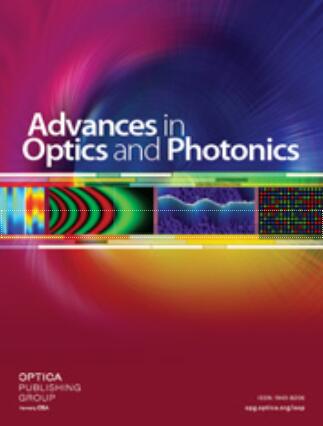铌酸锂薄膜集成光子学研究
IF 23.8
1区 物理与天体物理
Q1 OPTICS
引用次数: 289
摘要
铌酸锂(LN)是一种出色且用途广泛的材料,几十年来一直影响着我们的日常生活——从实现构成互联网主干的高速光通信到实现手机中使用的射频滤波。这种已有半个世纪历史的材料目前正在进行薄膜LN集成光子学的革命。晶圆级制造的成功、高质量的绝缘体上LN薄膜(LNOI)以及纳米制造技术的突破,使高性能集成纳米光子组件成为可能。随着过去几年的快速发展,这些薄膜LN器件中的一些,如光调制器和非线性波长转换器,已经超过了在体LN晶体中实现的传统器件。此外,纳米光子集成在LN中实现了超低损耗谐振器,开启了许多新的应用,如光学频率梳和量子换能器。在这篇综述中,我们涵盖了从基本原理到最新技术的集成薄膜LN光子学的各个方面,包括材料、基本无源元件和基于电光、全光非线性和声光的各种有源器件。我们还确定了该平台目前面临的挑战,并指出了未来的机遇。集成LNOI光子学领域正在迅速发展,并有望对通信、信号处理和量子信息的广泛应用产生重大影响。本文章由计算机程序翻译,如有差异,请以英文原文为准。
Integrated photonics on thin-film lithium niobate
Lithium niobate (LN), an outstanding and versatile material, has influenced our daily life for decades—from enabling high-speed optical communications that form the backbone of the Internet to realizing radio-frequency filtering used in our cell phones. This half-century-old material is currently embracing a revolution in thin-film LN integrated photonics. The successes of manufacturing wafer-scale, high-quality thin films of LN-on-insulator (LNOI) and breakthroughs in nanofabrication techniques have made high-performance integrated nanophotonic components possible. With rapid development in the past few years, some of these thin-film LN devices, such as optical modulators and nonlinear wavelength converters, have already outperformed their legacy counterparts realized in bulk LN crystals. Furthermore, the nanophotonic integration has enabled ultra-low-loss resonators in LN, which has unlocked many novel applications such as optical frequency combs and quantum transducers. In this review, we cover—from basic principles to the state of the art—the diverse aspects of integrated thin-film LN photonics, including the materials, basic passive components, and various active devices based on electro-optics, all-optical nonlinearities, and acousto-optics. We also identify challenges that this platform is currently facing and point out future opportunities. The field of integrated LNOI photonics is advancing rapidly and poised to make critical impacts on a broad range of applications in communication, signal processing, and quantum information.
求助全文
通过发布文献求助,成功后即可免费获取论文全文。
去求助
来源期刊

Advances in Optics and Photonics
OPTICS-
CiteScore
56.60
自引率
0.00%
发文量
13
期刊介绍:
Advances in Optics and Photonics (AOP) is an all-electronic journal that publishes comprehensive review articles and multimedia tutorials. It is suitable for students, researchers, faculty, business professionals, and engineers interested in optics and photonics. The content of the journal covers advancements in these fields, ranging from fundamental science to engineering applications.
The journal aims to capture the most significant developments in optics and photonics. It achieves this through long review articles and comprehensive tutorials written by prominent and respected authors who are at the forefront of their fields.
The journal goes beyond traditional text-based articles by enhancing the content with multimedia elements, such as animation and video. This multimedia approach helps to enhance the understanding and visualization of complex concepts.
AOP offers dedicated article preparation and peer-review support to assist authors throughout the publication process. This support ensures that the articles meet the journal's standards and are well-received by readers.
Additionally, AOP welcomes comments on published review articles, encouraging further discussions and insights from the scientific community.
In summary, Advances in Optics and Photonics is a comprehensive journal that provides authoritative and accessible content on advancements in optics and photonics. With its diverse range of articles, multimedia enhancements, and dedicated support, AOP serves as a valuable resource for professionals and researchers in these fields.
 求助内容:
求助内容: 应助结果提醒方式:
应助结果提醒方式:


